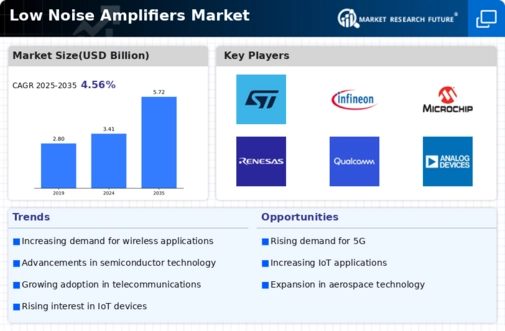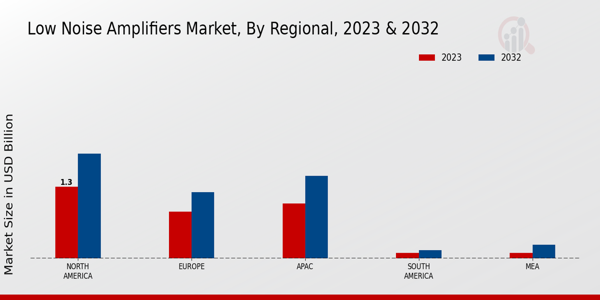Rising Demand in Consumer Electronics
The rising demand for consumer electronics is a significant driver of the Global Low Noise Amplifiers Market Industry. With the proliferation of smart devices, including smartphones, tablets, and smart home systems, the need for high-quality audio and video performance has become paramount. Low noise amplifiers play a crucial role in enhancing the performance of these devices by minimizing signal distortion and improving overall sound quality. This trend is expected to contribute to the market's growth, with an anticipated value of 3.41 USD Billion in 2024, as manufacturers seek to meet consumer expectations for superior audio experiences.
Advancements in Semiconductor Technology
Technological advancements in semiconductor materials and fabrication processes are significantly influencing the Global Low Noise Amplifiers Market Industry. Innovations such as the development of GaN and SiGe technologies enhance the performance of low noise amplifiers, allowing for higher frequency operation and improved efficiency. These advancements not only cater to the growing needs of telecommunications but also find applications in aerospace and defense sectors. As a result, the market is likely to experience a compound annual growth rate of 4.82% from 2025 to 2035, driven by the continuous evolution of semiconductor technologies.
Growing Demand for Wireless Communication
The increasing demand for wireless communication technologies is a primary driver of the Global Low Noise Amplifiers Market Industry. As mobile devices and IoT applications proliferate, the need for high-performance low noise amplifiers becomes critical to ensure signal integrity and quality. In 2024, the market is projected to reach 3.41 USD Billion, reflecting the industry's response to the surge in wireless communication requirements. This trend is expected to continue, with the market potentially expanding to 5.72 USD Billion by 2035, indicating a robust growth trajectory driven by advancements in wireless technologies.
Emerging Applications in Automotive Sector
Emerging applications of low noise amplifiers in the automotive sector are shaping the Global Low Noise Amplifiers Market Industry. As vehicles become increasingly equipped with advanced driver-assistance systems (ADAS) and infotainment systems, the demand for high-performance low noise amplifiers is on the rise. These components are essential for ensuring reliable communication between various electronic systems within vehicles. The automotive industry's shift towards electrification and automation is likely to further boost the demand for low noise amplifiers, contributing to a projected market growth rate of 4.82% CAGR from 2025 to 2035.
Increased Investment in Research and Development
The Global Low Noise Amplifiers Market Industry is witnessing increased investment in research and development activities. Companies are focusing on developing innovative low noise amplifier solutions that meet the stringent requirements of various applications, including satellite communications and medical devices. This investment is crucial for enhancing product performance and reliability, thereby attracting a broader customer base. As the market evolves, the emphasis on R&D is expected to drive growth, with projections indicating a market size of 5.72 USD Billion by 2035, reflecting the industry's commitment to innovation and excellence.
























Leave a Comment